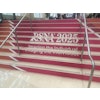As we prepared for this trip along the Road to RSNA, we were reminded that it was near this time in 1895 that Wilhelm Conrad Roentgen reported his discovery of x-rays. We can only imagine how he would react to some of the developments that will be reported at this year's meeting.
For instance, as a mechanical engineer and physicist, we think Roentgen would wonder at the development of dual-layer flat-panel detectors and recent work to improve their usability by a group at the University of Wisconsin-Madison. Researchers there have built a device with a liquid filter that can be quickly drained when these detectors are used for nonspectral imaging. This could improve radiation safety and clinical adoption of dual-layer flat-panel detectors, they suggest.
Also, researchers at the Technical University of Munich (TUM) continue to exploit the very nature of x-ray beams with their prototype dark-field chest x-ray machine. Collaborators from the TUM group will discuss the experimental approach in two presentations. One concerns how dark-field chest x-ray imaging compares with conventional x-ray when diagnosing pulmonary emphysema, and the second suggests that the approach stacks up against CT for diagnosing COVID-19.
However, there's no doubt that artificial intelligence algorithms developed using x-ray images lead the show in terms of studies to be presented. There are more studies this year evaluating the performance of commercially available algorithms. In one, researchers assessed the performance of an algorithm designed to assess hip dysplasia. In another, a PACS-integrated algorithm designed to detect pneumothorax on routine chest x-rays improved radiologist reporting times.
In addition, interventional radiology (IR) will make another strong appearance at RSNA 2022, with one study we've highlighted below finding that the use of the specialty has increased significantly among U.S. veterans. In so doing, IR has improved survival outcomes in patients with hepatocellular carcinoma (HCC), the researchers noted.
In another IR session, results will be presented from a multicenter study in Germany that suggests bone mineral density may be considered a prognostic factor for patients with HCC undergoing transarterial chemoembolization.
Keep reading for highlights of these and other digital x-ray presentations and posters scheduled for this year's meeting. You can also view the complete 2022 scientific and educational program on the RSNA 2022 website.
New device for dual-layer flat panel detectors developed
Sunday, November 27 | 10:30 a.m.-11:30 a.m. | S2-SSPH02-3 | N229
In this physics session on new imaging techniques, researchers will discuss developing a device with a liquid filter that can be quickly drained when flat-panel detectors (FPDs) are used for nonspectral imaging. The device could improve radiation safety and clinical adoption of these detectors, the researchers suggest.
Dark-field chest x-ray tested in pulmonary emphysema
Sunday, November 27 | 12:15 p.m.-12:45 p.m. | S3B-SPCH-7 | Learning Center - CH DPS
During this scientific poster session, new findings will be presented from a group at the Technical University of Munich in Germany suggesting that dark-field chest x-ray may outperform conventional x-ray for the diagnosis and staging of pulmonary emphysema.
Dark-field chest x-ray compared with CT in COVID-19 patients
Monday, November 28 |12:45 p.m.-1:15 p.m. | T5B-SPPH-9 | Learning Center - PH DPS
In this poster presentation, researchers will present a study exploring the capability of dark-field chest x-ray for detecting microstructural changes of the lung parenchyma, specifically in a comparison with CT imaging for the assessment of pneumonia in COVID-19 patients.
Are you ready to ditch lead radiation shields?
Monday, November 28 | 3:00 p.m.-4:00 p.m. | M7-CAS05 | N230B
For more than 70 years, radiographers have been taught that shielding patients is one of the core principles of radiation safety, but essentially this is no longer true, according to organizers of this educational course. Here, a panel of experts will walk attendees through the latest guidance on using shielding on patients during diagnostic x-ray exams.
IR may improve survival in U.S. veterans with liver cancer
Monday, November 28 | 3:00 p.m.-4:00 p.m. | M7-SSIR01-6 | Room E351
The context for this presentation is a recent marked increase in the use of interventional radiology (IR) in U.S. veterans with hepatocellular carcinoma (HCC). The researchers asked, "Is it having an impact on overall survival for these patients?"
Deep-learning model detects diabetes on x-rays
Wednesday, November 30 | 12:45 p.m. - 1:15 p.m. | W5B-SPCH-9 | Learning Center - CH DPS
In this scientific poster session, researchers will share their experience with using a deep-learning model to detect diabetes from ambulatory frontal x-rays in a large clinical dataset.
BMD helps predict survival in patients undergoing TACE
Wednesday, November 30 | 3:00 p.m.-4:00 p.m. | W7-SSIR03-2 | S502
German interventional radiologists will present results in this session of a multicenter study exploring bone mineral density as a prognostic factor for patients with hepatocellular carcinoma undergoing transarterial chemoembolization (TACE). Low bone mineral density (BMD) was recently identified as a novel risk factor for patients with hepatocellular carcinoma, and integrating BMD into novel scoring systems could improve survival prediction in these patients, the study authors found.




















